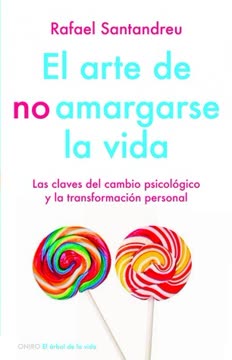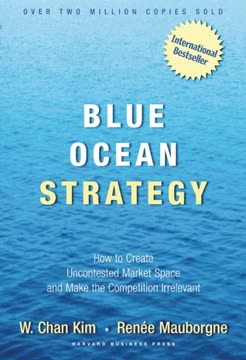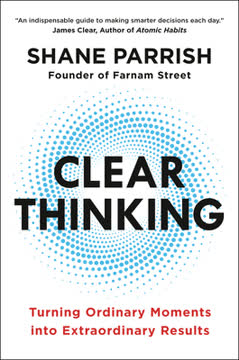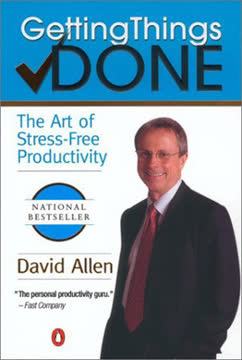Key Takeaways
1. Capture Everything: Clear Your Mind by Externalizing Tasks
"Your mind is for having ideas, not holding them."
Free your mind. The first step to achieving stress-free productivity is to capture everything that has your attention into a trusted external system. This includes tasks, ideas, commitments, and anything else occupying mental space. By doing so, you free up cognitive resources and reduce stress caused by trying to remember everything.
Create a collection habit. Develop the habit of immediately capturing thoughts and tasks as they occur. Use tools like notebooks, digital apps, or voice recorders to ensure you always have a means to externalize information. This practice prevents important items from slipping through the cracks and allows your mind to focus on the task at hand rather than juggling multiple commitments.
Trust your system. The key to successful capture is trusting that your system will reliably remind you of tasks and ideas when needed. This trust allows you to fully engage in the present moment without worrying about forgetting important commitments. Regularly review and maintain your capture tools to reinforce this trust and ensure nothing gets lost in the process.
2. Process Inbox to Zero: Define Next Actions for Each Item
"The key to managing all of your stuff is managing your actions."
Clarify and decide. Once you've captured everything, the next crucial step is to process your inbox to zero. This means going through each item and deciding what it means and what needs to be done about it. The goal is to turn vague ideas and commitments into clear, actionable steps.
Define next actions. For every item, ask yourself, "What's the next action?" This question forces you to clarify exactly what needs to be done to move the item forward. By defining concrete next actions, you remove ambiguity and make it easier to take action when the time comes.
Organize appropriately. Based on your decision about each item, organize it into the appropriate category:
- Next actions list
- Project list (for items requiring multiple steps)
- Waiting for list (for items delegated to others)
- Someday/Maybe list (for ideas to consider later)
- Reference material (for information to keep but not act on)
- Trash (for items no longer needed)
3. Organize Actions by Context: Create Focused Lists
"The brain is for having ideas, not for holding them."
Context-based organization. Organize your next actions by context, not by project or priority. Contexts are the tools, locations, or conditions needed to complete a task. Common contexts include:
- @Computer
- @Phone
- @Errands
- @Home
- @Office
- @Agenda (for topics to discuss with specific people)
Increase efficiency. By grouping tasks by context, you can easily see all available actions when you're in a particular situation. This approach minimizes task-switching and helps you make the most of your time and resources. For example, when you're at your computer, you can quickly scan your @Computer list and tackle multiple tasks efficiently.
Adapt to your workflow. Tailor your contexts to your specific needs and lifestyle. Create contexts that reflect your unique work environment and responsibilities. Regularly review and refine your context lists to ensure they remain relevant and useful as your circumstances change.
4. Review Regularly: Weekly Check-ins Keep You on Track
"It's a waste of time and energy to keep thinking about something that you make no progress on."
Weekly review ritual. Establish a consistent weekly review practice to maintain control and perspective. During this review, process all inboxes, update your lists, and review your calendar. This habit ensures that your system remains current and trustworthy, allowing you to confidently focus on your current priorities.
Key components of the weekly review:
- Clear all collection tools (inboxes, notes, voice memos)
- Process new items and add to appropriate lists
- Review previous calendar data for remaining action items
- Review upcoming calendar for preparation needs
- Review project lists for new next actions
- Review Waiting For list and follow up as needed
- Review Someday/Maybe list for items to activate or remove
Gain perspective. Use the weekly review to zoom out and assess your overall commitments and goals. This broader view helps you make better decisions about where to focus your energy in the coming week and ensures that you're making progress on important long-term objectives.
5. Do, Delegate, or Defer: The Two-Minute Rule for Efficiency
"If an action will take less than two minutes, it should be done at the moment it is defined."
Immediate action. The Two-Minute Rule states that if a task can be completed in two minutes or less, do it immediately. This principle prevents small tasks from piling up and clogging your system. By quickly dispatching these minor items, you maintain momentum and keep your workflow smooth.
Effective delegation. For tasks that you're not the best person to handle, delegate immediately. Clearly communicate the desired outcome, any relevant context, and your expectations for follow-up. Keep track of delegated items in your Waiting For list to ensure nothing falls through the cracks.
Strategic deferral. For tasks that require more than two minutes and can't be delegated, defer them by adding them to your Next Actions list or calendar. Be specific about the next physical action required to move the task forward. This clarity makes it easier to engage with the task when you have the time and resources to tackle it.
6. Project Planning: Natural Planning Model for Effective Execution
"The natural planning model is a way to leverage the way your mind works to create more clarity, focus, and efficiency in your projects."
Five stages of natural planning:
- Define purpose and principles
- Visualize outcomes
- Brainstorm ideas
- Organize ideas
- Identify next actions
Leverage your mind's natural process. This model mirrors the way your mind naturally approaches planning. By consciously applying these stages to your projects, you can tap into your brain's innate problem-solving capabilities and generate more creative and effective solutions.
Iterate as needed. The natural planning model is not a linear, one-time process. As you work on a project, you may need to revisit earlier stages to refine your approach. Regularly applying this model to your projects keeps them aligned with your goals and ensures steady progress.
7. Mastering Workflow: The Five Stages of Getting Things Done
"You can do anything, but not everything."
The GTD workflow:
- Capture: Collect what has your attention
- Clarify: Process what it means
- Organize: Put it where it belongs
- Reflect: Review frequently
- Engage: Simply do
Continuous process. These five stages form a continuous cycle for managing your commitments and tasks. By consistently moving through these stages, you maintain control over your workflow and reduce stress associated with unmanaged obligations.
Flexibility and adaptability. The GTD system is not rigid; it's designed to be flexible and adaptable to your unique needs and circumstances. As you implement the system, focus on understanding the principles behind each stage and adapt them to work best for you.
8. Mind Like Water: Achieve Relaxed Control and Focus
"Your ability to generate power is directly proportional to your ability to relax."
Responsive, not reactive. The concept of "mind like water" comes from martial arts. Like water, which responds appropriately to any force applied to it, your mind should be calm and ready to respond appropriately to whatever comes your way. This state allows for maximum effectiveness with minimum effort.
Clear mental space. By implementing a trusted system for capturing and organizing all your commitments, you free your mind from the burden of trying to remember everything. This mental clarity allows you to focus fully on the task at hand, leading to increased productivity and creativity.
Stress reduction. Achieving a "mind like water" state significantly reduces stress and anxiety. When you trust that all your commitments are captured and organized in a system you can rely on, you no longer worry about forgetting important tasks or feeling overwhelmed by the sheer volume of things to do.
9. Horizons of Focus: Aligning Actions with Long-Term Goals
"You can't really define your priorities until you know what your work is."
Six horizons of focus:
- Ground level: Current actions
- 10,000 feet: Current projects
- 20,000 feet: Areas of responsibility
- 30,000 feet: 1-2 year goals
- 40,000 feet: 3-5 year vision
- 50,000 feet: Life purpose
Vertical alignment. Regularly reviewing these horizons ensures that your day-to-day actions align with your broader goals and life purpose. This alignment brings a sense of meaning and direction to even the smallest tasks.
Dynamic balance. While it's important to have a clear vision at the higher altitudes, don't neglect the ground level. The key to productivity is maintaining a dynamic balance between long-term vision and short-term action. Regular reviews of all horizons help maintain this balance.
10. The Art of the Next Action: Moving Projects Forward
"The secret of getting ahead is getting started. The secret of getting started is breaking your complex overwhelming tasks into small manageable tasks, and then starting on the first one."
Concrete next steps. The power of defining next actions lies in its concreteness. Instead of vague projects or goals, you identify the specific, physical action needed to move forward. This clarity eliminates procrastination and makes it easier to engage with your tasks.
Project momentum. By consistently identifying and executing next actions, you maintain steady progress on your projects. This approach prevents projects from stalling due to lack of clarity or overwhelm. Even small actions can create momentum and lead to significant progress over time.
Decision-making tool. The next action question serves as a powerful decision-making tool in meetings and conversations. By always clarifying the next action and who's responsible for it, you ensure that discussions lead to concrete outcomes and forward movement.
11. Stress-Free Productivity: Breaking the Psychological Loops
"Much of the stress that people feel doesn't come from having too much to do. It comes from not finishing what they've started."
Psychological completion. Unfinished tasks and unclear commitments create mental loops that consume energy and create stress. By capturing these open loops in a trusted system and clarifying the next actions, you achieve a sense of psychological completion, even before the task is actually done.
Renegotiating commitments. Regularly reviewing your commitments allows you to renegotiate them with yourself and others. This process is crucial for maintaining realistic expectations and preventing overwhelm. Remember, you can:
- Complete the commitment
- Change the commitment
- Cancel the commitment
Focus on what you can control. By concentrating on defining and taking next actions, you focus on what you can control in the present moment. This approach reduces anxiety about the future and increases your sense of effectiveness and progress.
12. Building a Trusted System: The Key to Sustainable Success
"Your mind is for having ideas, not holding them."
System integrity. The effectiveness of the GTD system depends on its integrity. Every part of the system—capture, clarify, organize, reflect, and engage—must be consistently maintained for the whole to function properly. Regular upkeep ensures that you can trust your system to hold and manage all your commitments.
Habit formation. Implementing GTD is not a one-time event but a process of building new habits. Start small, focusing on one aspect of the system at a time. As these habits become ingrained, the entire system becomes more natural and effortless to maintain.
Continuous improvement. Your GTD system should evolve as your life and work change. Regularly assess the effectiveness of your tools and processes, and be willing to make adjustments. This flexibility ensures that your system continues to serve you well over time.
Last updated:
FAQ
What's Organízate con eficacia about?
- Focus on Organization: Organízate con eficacia by David Allen presents a system for organizing work to free the mind from stress, enhancing creativity and efficiency.
- Limited Mind Capacity: Allen emphasizes our minds' limited capacity for storing information, advocating for practical formulas to reduce tension and improve productivity.
- Practical Techniques: The book outlines simple rules for time management, such as identifying the next step in projects and the two-minute rule for quick tasks.
- Integration of Life and Work: It integrates personal and professional aspects, encouraging a holistic view of tasks as part of a cohesive system.
Why should I read Organízate con eficacia?
- Boost Productivity: If you struggle with managing tasks and feel overwhelmed, this book offers proven methods to enhance productivity without stress.
- Transform Work Approach: It provides insights into changing how you perceive daily challenges, making work feel more manageable and less daunting.
- Applicable to All Areas: Techniques can be applied in both personal and professional contexts, making it a versatile guide for improving organizational skills.
- Long-term Benefits: The principles can lead to lasting changes in how one approaches work and life, fostering a more organized and fulfilling lifestyle.
What are the key takeaways of Organízate con eficacia?
- Five Steps to Control Workflow: The book outlines a five-step process: Collect, Process, Organize, Review, and Do.
- Mind Like Water: Achieving a "mind like water" state is crucial for maintaining focus and clarity, allowing for better decision-making and action.
- Next Action Decision: Identifying the next physical action required for each task is essential for moving projects forward and reducing mental clutter.
- Regular Reviews: Conduct weekly reviews of tasks and projects to maintain clarity and focus, ensuring you stay on top of commitments.
What is the two-minute rule in Organízate con eficacia?
- Immediate Action for Quick Tasks: If a task can be completed in less than two minutes, it should be done immediately rather than postponed.
- Efficiency Boost: This rule helps prevent small tasks from piling up, which can lead to increased stress and decreased productivity.
- Practical Application: Implementing this rule can free up mental space and allow for a more organized approach to larger projects.
- Flexibility in Time: While two minutes is the guideline, you can extend this to five or ten minutes for processing tasks if you have more time.
How does David Allen suggest processing tasks in Organízate con eficacia?
- One at a Time: Process items from your collection one by one, starting with the top item in your inbox or "cesto."
- Decide Action for Each: For each item, determine what it is, what action is required, and where it should go in your organizational system.
- No Returning to the Cesto: Once you take an item out to process, do not return it to the cesto without deciding its fate.
- Clarity in Decision-Making: This method ensures clarity and prevents tasks from becoming overwhelming.
What is the importance of defining purpose in project planning according to Organízate con eficacia?
- Clarifies Goals: Defining the purpose of a project helps clarify what success looks like and guides decision-making throughout the project.
- Motivates Action: A clear purpose can motivate individuals and teams to stay focused and committed to achieving the desired outcome.
- Sets Standards: Establishing a purpose also sets the standards and principles that will guide the project, ensuring alignment among team members.
- Guides Execution: It provides a framework for executing tasks effectively and efficiently.
What are the five phases of project planning in Organízate con eficacia?
- Define Purpose and Principles: Start by clarifying the project's purpose and the principles that will guide its execution.
- Visualize Results: Create a clear mental image of what success looks like to help guide the planning process.
- Generate Ideas: Engage in brainstorming to gather all potential ideas and actions related to the project.
- Organize: Structure the ideas into components, sequences, and priorities to create a coherent plan.
- Identify Next Actions: Determine the specific next actions required to move the project forward.
How can I implement the techniques from Organízate con eficacia in my daily life?
- Set Aside Time: Dedicate specific time blocks to implement the techniques, ensuring minimal interruptions during this period.
- Create a Workspace: Establish a physical workspace that is organized and equipped with the necessary tools for effective task management.
- Use Tools and Systems: Utilize both low-tech (notebooks, folders) and high-tech (digital calendars, task management apps) tools to keep track of tasks and projects.
- Regular Practice: Consistently apply the methods to develop a habit of organized and efficient task management.
What is the significance of the "mind like water" concept in Organízate con eficacia?
- State of Clarity: A "mind like water" refers to a mental state where one is calm, clear, and responsive, allowing for effective decision-making.
- Adaptability: This state enables individuals to adapt to changing circumstances without becoming overwhelmed or stressed.
- Enhanced Focus: Achieving this mental clarity is essential for maintaining focus on tasks and projects, leading to improved productivity.
- Stress Reduction: It helps in reducing stress by promoting a balanced and composed approach to challenges.
What are some common pitfalls to avoid when applying the methods in Organízate con eficacia?
- Overcomplicating the System: Avoid creating overly complex systems that are difficult to maintain; simplicity is key to effectiveness.
- Neglecting Regular Reviews: Failing to regularly review and update your lists and systems can lead to clutter and decreased productivity.
- Ignoring the Two-Minute Rule: Not applying the two-minute rule can result in small tasks accumulating, leading to increased stress and mental clutter.
- Lack of Consistency: Inconsistent application of the methods can undermine their effectiveness.
How does Organízate con eficacia define a project?
- Any Outcome Requiring Multiple Actions: A project is defined as any result that requires more than one action to complete.
- Importance of Clarity: Understanding what constitutes a project allows for better organization and prioritization of tasks.
- Creating a Project List: The book encourages readers to maintain a comprehensive list of all their projects.
- Tracking Progress: This list serves as a reminder of ongoing commitments and helps in tracking progress.
How can I implement the Weekly Review suggested in Organízate con eficacia?
- Set Aside Time: Dedicate a specific time each week to conduct your review, ideally when you can focus without interruptions.
- Process All Inputs: Gather all notes, emails, and tasks that have accumulated over the week and process them.
- Evaluate Projects and Actions: Review your project list and next actions to ensure everything is up to date.
- Maintain Clarity: This practice helps maintain clarity and focus on your commitments.
Review Summary
Organízate con eficacia receives mixed reviews, with an average rating of 4 out of 5. Many readers find the GTD methodology helpful for improving productivity and reducing stress, praising its structured approach to task management. Some appreciate the book's practical tools and life-changing potential. However, several reviewers note that the book can be dense, repetitive, and outdated in parts. While some consider it essential reading for productivity enthusiasts, others feel it could have been more concise and straightforward in presenting the core concepts.
Similar Books








Download PDF
Download EPUB
.epub digital book format is ideal for reading ebooks on phones, tablets, and e-readers.








